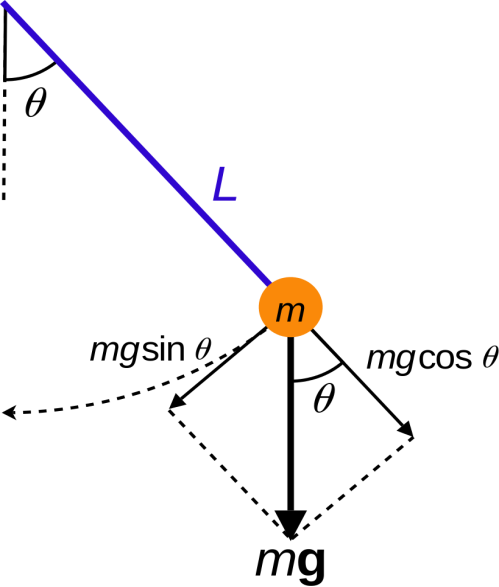
Define ideal simple pendulum. Show that under certain conditions, a simple pendulum performs linear simple harmonic motion.
Answer
575.1k+ views
Hint: Whenever the force is directly proportional to the negative of displacement, then it means that the body will execute a simple harmonic motion.
Complete step by step answer:
Ideal simple pendulum: An ideal simple pendulum is one which consists of a point mass suspended by a weightless inextensible perfectly flexible thread and free to vibrate without any friction.
Simple pendulum executing simple harmonic motion:
Let the mass of the bob is m, and L is the length to which it is suspended from a rigid support.
Let $\theta $ be the small angle in the vertical plane to which it is displaced, g is the acceleration due to gravity. Now resolves the weight components in vertical and horizontal components.
The two resolved components are $mg\sin \theta $ and$mg\cos \theta $.
Now the restoring force is given by-
$F = - mg\sin \theta $
Now as $\theta $ is very small therefore,$\sin \theta \approx \theta $
$F = - mg\theta $ …………..(1)
And $\theta = \dfrac{x}{L}$
Now substituting this in eq.(1) we get,
$F = - mg\left( {\dfrac{x}{L}} \right)$
$ \Rightarrow F \propto \left( { - x} \right)$
Since the restoring force is directly proportional to the negative of the displacement, hence the motion of the simple pendulum is simple harmonic in nature (SHM).

Conditions for a simple pendulum: Followings are the conditions of a simple pendulum-
(i) Bob must be a point heavy mass.
(ii) It must be suspended with a thread of negligible weight.
(iii) It must be supported by rigid support.
(iv) The amplitude should be very small.
Note:
Also remember that the acceleration is given by-
$
ma = - mg\dfrac{x}{L} \\
\Rightarrow a = - \dfrac{x}{L}g \\
$
Magnitude of Acceleration per unit displacement $\left| {\dfrac{a}{x}} \right| = \dfrac{g}{L}$
Time period is given by-
$
T = \dfrac{{2\pi }}{{\sqrt {\dfrac{g}{L}} }} \\
\Rightarrow T = 2\pi \sqrt {\dfrac{L}{g}} \\
$
Complete step by step answer:
Ideal simple pendulum: An ideal simple pendulum is one which consists of a point mass suspended by a weightless inextensible perfectly flexible thread and free to vibrate without any friction.
Simple pendulum executing simple harmonic motion:
Let the mass of the bob is m, and L is the length to which it is suspended from a rigid support.
Let $\theta $ be the small angle in the vertical plane to which it is displaced, g is the acceleration due to gravity. Now resolves the weight components in vertical and horizontal components.
The two resolved components are $mg\sin \theta $ and$mg\cos \theta $.
Now the restoring force is given by-
$F = - mg\sin \theta $
Now as $\theta $ is very small therefore,$\sin \theta \approx \theta $
$F = - mg\theta $ …………..(1)
And $\theta = \dfrac{x}{L}$
Now substituting this in eq.(1) we get,
$F = - mg\left( {\dfrac{x}{L}} \right)$
$ \Rightarrow F \propto \left( { - x} \right)$
Since the restoring force is directly proportional to the negative of the displacement, hence the motion of the simple pendulum is simple harmonic in nature (SHM).

Conditions for a simple pendulum: Followings are the conditions of a simple pendulum-
(i) Bob must be a point heavy mass.
(ii) It must be suspended with a thread of negligible weight.
(iii) It must be supported by rigid support.
(iv) The amplitude should be very small.
Note:
Also remember that the acceleration is given by-
$
ma = - mg\dfrac{x}{L} \\
\Rightarrow a = - \dfrac{x}{L}g \\
$
Magnitude of Acceleration per unit displacement $\left| {\dfrac{a}{x}} \right| = \dfrac{g}{L}$
Time period is given by-
$
T = \dfrac{{2\pi }}{{\sqrt {\dfrac{g}{L}} }} \\
\Rightarrow T = 2\pi \sqrt {\dfrac{L}{g}} \\
$
Recently Updated Pages
Master Class 12 Economics: Engaging Questions & Answers for Success

Master Class 12 Maths: Engaging Questions & Answers for Success

Master Class 12 Biology: Engaging Questions & Answers for Success

Master Class 12 Physics: Engaging Questions & Answers for Success

Master Class 8 Maths: Engaging Questions & Answers for Success

Class 8 Question and Answer - Your Ultimate Solutions Guide

Trending doubts
Which animal has three hearts class 11 biology CBSE

1 Quintal is equal to a 110 kg b 10 kg c 100kg d 1000 class 11 physics CBSE

Explain zero factorial class 11 maths CBSE

Mention the basic forces in nature class 11 physics CBSE

What is centripetal acceleration Derive the expression class 11 physics CBSE

Bond order ofO2 O2+ O2 and O22 is in order A O2 langle class 11 chemistry CBSE




